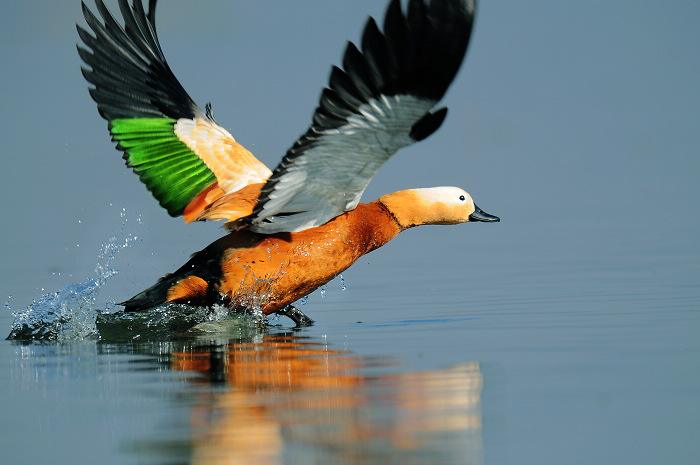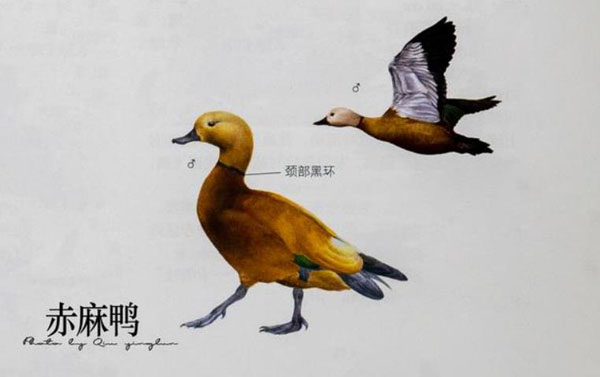Tadorna ferruginea
IUCN
LCBasic Information
Scientific classification
- name:Tadorna ferruginea
- Scientific Name:Yellow duck, yellow duck, duck, red goose,Ruddy Shelduck
- Outline:Waterfowl
- Family:Anseriformes Anatidae Tadorna
Vital signs
- length:Males 516-670 mm, females 510-680 mm
- Weight:Male 1000-1656g, female 969-1689g
- lifetime:8 years
Feature
What the ancients called "mandarin ducks".
Distribution and Habitat
Distributed in Afghanistan, Albania, Algeria, Armenia, Azerbaijan, Bangladesh, Bhutan, Bulgaria, China, Cyprus, Denmark, Egypt, Ethiopia, Georgia, Greece, India, Islamic Republic of Iran, Iraq, Israel, Italy, Kazakhstan, South Korea, Kuwait, Kyrgyzstan, Lao People's Democratic Republic, Libya, Moldova, Mongolia, Morocco, Myanmar, Nepal, Oman, Pakistan, Qatar, Romania, Saudi Arabia, Spain (Canary Islands), Sudan, Syrian Arab Republic, Tajikistan, Thailand, Tunisia, Turkey, Ukraine, United Arab Emirates, Uzbekistan, Vietnam, Western Sahara. Regional extinction: Turkmenistan.
It lives in various habitats such as rivers, lakes, estuaries, ponds and nearby grasslands, wastelands, swamps, beaches, farmlands and plain sparse forests, especially in the lake areas on the plains. It mainly lives in inland freshwater, and is sometimes found on seaside beaches, saltwater lakes, and open grasslands far away from water.
Appearance
The male Ruddy Shelduck has a brownish-white head; the cheeks, throat, front neck and sides of the neck are light brownish-yellow; there is a narrow black collar ring at the base of the lower neck during the breeding season; the chest, upper back and shoulders are all reddish-yellow brown; the lower back is slightly lighter; the waist feathers are brownish-brown with dark brown insect-like spots; the tail and upper tail coverts are black; the upper wing coverts are white, slightly stained with brown; the winglets and primary flight feathers are dark brown, the outer vanes of the secondary flight feathers are brilliant green, forming a distinct green wing mirror, and the outer vanes of the three tertiary flight feathers are brownish-brown; the lower body is brownish-yellow brown, of which the upper chest and lower abdomen and the undertail coverts are the darkest; the armpits and underwing coverts are white. The female bird's plumage is similar to that of the male, but the body col
Details
There is a kind of "duck" that is slightly larger than a domestic duck, but has golden feathers all over its body. In fact, this is not a domestic duck, but a Ruddy Shelduck, which is a kind of bird.

Speaking of lovebirds, everyone will think of the poem "I wish to be lovebirds in the sky, and I wish to be intertwined branches on the ground. The eternity of heaven and earth will end someday, but this endless hatred will never end." There are also lovebirds in Cao Zhi's "Two Poems to Send Off Ying" in the Three Kingdoms: "The mountains and rivers are far away, and the separation will shorten our reunion. I wish to be lovebirds, spread my wings and fly high." It can be traced back to the "Classic of Mountains and Seas", which records that in Chongwu Mountain in northwest China, "there is a bird on Chongwu Mountain, which looks like a duck, but has one wing and one eye. It can fly only when it is together. It is called Manman. When it is seen, there will be floods in the world." That is to say, the male and female "Manman" birds each have one eye, one wing, and one foot. Only when the male and female birds hold each other can they act together, and thus become a symbol of lovebirds.

Obviously, there is no half-bird with only one eye, one wing, and one leg in nature. "Its appearance is like a duck" refers to a wild duck. Among wild ducks, there is indeed a kind of red-crested pochard. During the breeding season, the male and female live together and fly together, inseparable, and the rhythm of flapping their wings is very consistent. From a distance, they look like one bird. As the saying goes, "They fly together when they get along well", so the probability that the ancients who lacked telescopes mistakenly thought it was a half-bird is very high. As for the saying "seeing it means flooding in the world", it is not entirely absurd. When the red-crested pochard breeds in the northwest desert area, it is the spring flood season, which is the peak flood season. It still has a materialistic basis.
In fact, compared with the mandarin ducks we are familiar with, the red-crested pochard is the authentic mandarin duck, while in ancient times, mandarin ducks were called purple mandarin ducks, also called 鸂鶒 (pronounced "西翅"). The great Tang Dynasty poet Li Bai wrote in "Ancient Style: Tianjin March": "Seventy purple mandarin ducks, playing in pairs in the courtyard. Enjoying day and night, saying that they have spent a thousand years." Li Bai is a master of bird watching, and he is naturally very clear about the difference between mandarin ducks and purple mandarin ducks. After the Song Dynasty, the purple in "purple mandarin ducks" was gradually ignored, and 鸂鶒 gradually took the name of the red-crested pochard as the mandarin duck, becoming a symbol of love birds, while the real mandarin duck-the red-crested pochard was quietly forgotten.
This species has a wide distribution range and is not close to the critical value of vulnerable and endangered species survival (distribution area or fluctuation range is less than 20,000 square kilometers, habitat quality, population size, and fragmented distribution area). The population trend is stable, so it is evaluated as a species with no survival crisis.
Listed in the 2012 Red List of Endangered Species of the World Conservation Union (IUCN) ver 3.1 - Least Concern (LC).
Listed in the "List of Terrestrial Wildlife with Important Economic and Scientific Research Value under State Protection" issued by the State Forestry Administration of China on August 1, 2000, it is called "Three Have" animals.








